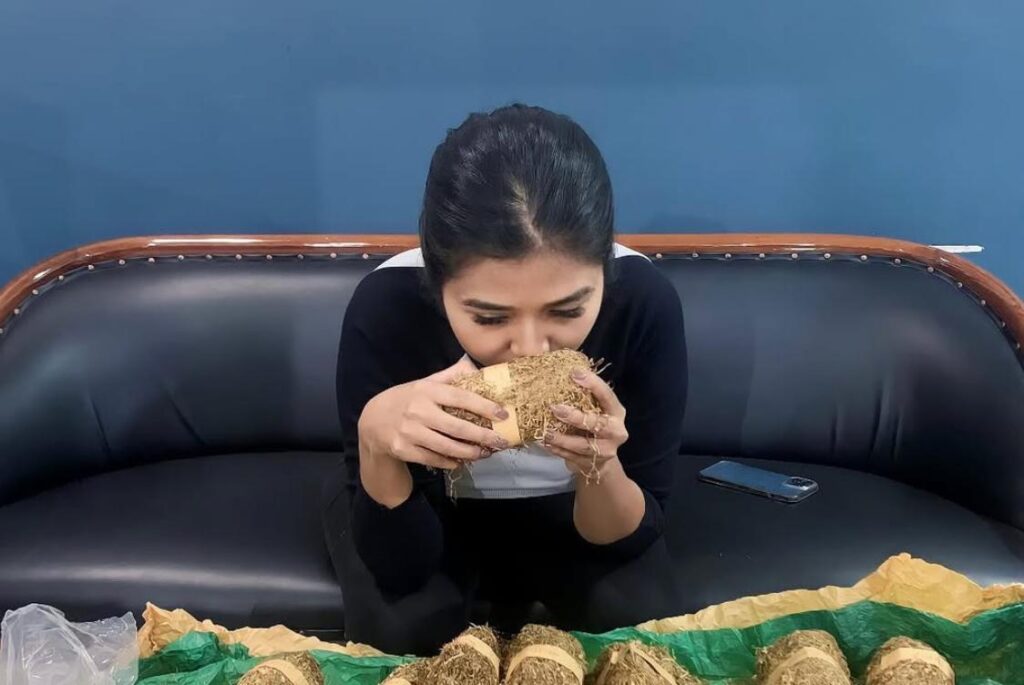Gadis Kretek menjadi simbol baru kebangkitan industri tembakau tradisional Indonesia. Di tengah derasnya arus modernisasi dan rokok elektrik, seorang perempuan muda bernama Awalia Rismala muncul sebagai sosok yang berani melawan arus. Ia bukan sekadar produsen, tetapi penjaga warisan: memastikan bahwa aroma, cita rasa, dan filosofi kretek tetap hidup di tanah Nusantara.
Perjalanan Awalia Membangun Warisan Kretek
Awalia Rismala bukan berasal dari keluarga pabrikan besar. Ia memulai segalanya dari lantai produksi dari jari-jemari yang menggulung tembakau satu per satu hingga memahami rahasia racikan rasa yang membuat kretek menjadi identitas bangsa.
Di awal kariernya, Awalia bergabung sebagai pelinting di sebuah usaha kecil di Semarang. Dari sana, ia jatuh cinta pada dunia tembakau. Ia belajar langsung bagaimana daun tembakau dipilih, dikeringkan, hingga dipadukan dengan cengkih yang memberi aroma khas Indonesia. Dedikasinya membuatnya dikenal sebagai “Gadis Kretek,” julukan yang kini menjadi identitas profesional sekaligus simbol perjuangannya.
Dengan ketekunan, ia bertransformasi dari pekerja lapangan menjadi peracik, lalu membangun pabrik kecil miliknya sendiri di kawasan Mijen, Semarang. Bersama Damayanti Zahar, sesama penggiat kretek tradisional, Awalia membentuk kemitraan untuk menghidupkan kembali varian kretek khas Nusantara yang dibuat sepenuhnya dengan tangan.
Filosofi di Balik Kretek Tradisional
Di balik setiap lintingan kretek, tersimpan filosofi mendalam tentang ketenangan, kerja, dan rasa. Bagi Awalia, kretek bukan sekadar produk konsumsi, melainkan karya budaya. Ia percaya bahwa rokok yang baik harus lahir dari hati yang baik.
Cita Rasa dari Alam, Bukan Pabrik
Produksi kretek di pabrik Awalia berpegang pada prinsip alami. Semua bahan baku berasal langsung dari petani lokal Jawa Tengah tanpa perantara. Tembakau dipilih secara manual berdasarkan kelembapan dan warna.
Proses selanjutnya adalah pembuatan saus jantung dari aroma kretek. Saus racikan Awalia dibuat melalui fermentasi alami dari tomat, wortel, daun mint, kayu manis, serta bumbu tradisional lain yang ia rahasiakan. Hasilnya adalah cita rasa yang lembut, manis, dan khas.
Tanpa bahan kimia tambahan, setiap batang kretek memiliki keunikan rasa. Seperti yang sering dikatakan Damayanti Zahar, “Kretek alami tak pernah seragam. Hari ini bisa lembut, besok bisa tajam. Tapi di situlah seninya — seperti kehidupan itu sendiri.”
Filosofi Pekerja dan Cinta dalam Setiap Lintingan
Mayoritas pekerja di pabrik Awalia adalah perempuan dari desa sekitar. Salah satu di antaranya, Siti Rodiyah, menceritakan filosofi yang diwariskan turun-temurun: melinting tembakau dengan hati yang bahagia.
Menurutnya, rasa dalam kretek tidak hanya berasal dari bahan, tetapi juga dari suasana hati pembuatnya. “Kalau lagi marah atau sedih, rasa rokok bisa berubah jadi pahit,” ujarnya sambil tersenyum. Filosofi ini menjadi nilai yang ditanamkan Awalia dalam seluruh proses produksinya, bahwa setiap batang kretek adalah hasil dari kerja yang penuh cinta dan kesabaran.
Menantang Arus Rokok Elektrik
Kehadiran rokok elektrik dan industri nikotin modern menjadi tantangan besar bagi pelaku kretek tradisional. Namun Awalia tidak gentar. Baginya, teknologi boleh berkembang, tetapi budaya tidak boleh hilang.
Edukasi Generasi Muda Tentang Kretek
Awalia secara aktif mengadakan lokakarya di berbagai kota di Jawa Tengah dan Jawa Timur. Dalam setiap sesi, ia mengajak generasi muda untuk mengenal sejarah kretek dari masa kolonial hingga menjadi simbol identitas Indonesia.
Ia menekankan bahwa kretek lahir dari tangan rakyat, bukan mesin industri asing. “Kalau kita lupa cara membuatnya, kita kehilangan bagian dari diri kita sendiri,” katanya dalam sebuah forum pelestarian budaya.
Melawan Stereotip dan Stigma
Di tengah stigma terhadap industri rokok, Awalia menempatkan dirinya bukan sebagai produsen konsumsi, tetapi sebagai pelestari budaya. Ia menolak anggapan bahwa kretek hanya soal kebiasaan merokok. “Kretek adalah seni. Ini bukan tentang kecanduan, tapi tentang rasa, sejarah, dan tangan-tangan manusia yang bekerja dengan hati,” ujarnya.
Dengan pendekatan itu, ia berhasil menarik perhatian banyak pihak, termasuk komunitas pelestari budaya dan beberapa lembaga pendidikan yang kini menjadikan kretek sebagai studi etnografi.

Pabrik Kecil, Dampak Besar
Meski skala produksinya belum sebesar pabrikan nasional, pabrik Awalia di Mijen menjadi pusat ekonomi lokal. Ratusan perempuan menggantungkan hidup pada industri ini, sebuah bukti bahwa kretek tradisional masih relevan di tengah modernisasi.
Pemberdayaan Perempuan Lewat Tembakau
Awalia sengaja merekrut tenaga kerja perempuan, terutama dari keluarga pra-sejahtera. Ia percaya perempuan memiliki ketelitian dan ketekunan tinggi dalam melinting tembakau. “Mereka bukan hanya pekerja, tapi seniman rasa,” katanya.
Di setiap sudut ruang produksi, suasana terasa hangat. Para pekerja bercanda, tertawa, dan bernyanyi sambil melinting. Bagi Awalia, inilah bentuk nyata dari ekonomi yang humanis pekerjaan yang memberi arti dan kebahagiaan.
Membangun Ekosistem Berkelanjutan
Selain pemberdayaan, Awalia juga menanamkan prinsip berkelanjutan. Ia menjalin kemitraan langsung dengan petani tembakau di Temanggung dan Wonosobo. Sistemnya tanpa tengkulak, dengan pembelian langsung di atas harga pasar.
Langkah ini membuat rantai pasok lebih adil dan menghidupkan kembali semangat gotong royong antara petani dan pelaku industri. “Kalau petani sejahtera, tembakau pun tumbuh dengan cinta,” ujarnya.
Kretek Sebagai Warisan dan Identitas
Kini, nama Awalia Rismala mulai dikenal di berbagai forum kebudayaan dan pameran industri lokal. Banyak pihak menyebutnya sebagai penerus generasi perintis kretek Indonesia, sekaligus wajah baru yang membawa sentuhan perempuan dalam industri yang dulu didominasi laki-laki.
Dari Mijen ke Nusantara
Visi Awalia tidak berhenti di Semarang. Ia berencana memperkenalkan kretek tradisional ke berbagai daerah Indonesia dengan pendekatan edukatif. Bukan sekadar menjual, tetapi mengajarkan makna di balik setiap lintingan.
Ia juga tengah menyiapkan museum mini kretek di pabriknya, tempat publik bisa melihat langsung proses pembuatan, bahan baku alami, dan sejarah tembakau dari masa ke masa.
Kolaborasi Budaya dan Ekonomi
Ke depan, Awalia membuka peluang kolaborasi dengan komunitas seni dan UMKM lokal. Ia ingin menciptakan ruang kreatif di mana kretek tidak hanya dipandang sebagai produk, tetapi juga inspirasi karya.
Dalam beberapa bulan terakhir, ia menggandeng pengrajin lokal untuk membuat kemasan ramah lingkungan dengan motif batik khas Semarang. Hasilnya, kretek buatannya tak hanya nikmat, tapi juga estetis perpaduan antara rasa dan rupa budaya Indonesia.
Kisah Gadis Kretek Awalia Rismala adalah kisah tentang ketekunan, idealisme, dan cinta terhadap warisan bangsa. Di tengah dunia yang serba instan, ia memilih jalan yang pelan namun bermakna: menjaga tradisi dengan tangan, hati, dan jiwa.
Melalui setiap lintingan, Awalia mengingatkan bahwa budaya tidak akan punah selama ada yang mau menjaganya. Dan dari pabrik kecil di Mijen, aroma kretek Nusantara terus mengepul membawa pesan bahwa warisan Indonesia akan selalu hidup, sepanjang ada generasi yang mau meneruskannya.
Discover more from Insimen
Subscribe to get the latest posts sent to your email.





























